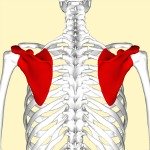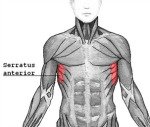Pain In Upper Right Back Treatment
The techniques I demonstrate for you are very simple. So please do take your time and watch the videos at your own pace. Pausing the video, rewinding, and viewing the videos multiple times is not only allowed, but is highly encouraged.
Go directly to any Pain In Upper Right Back video with these links:
Intro,
Video 1,
Video 2,
Video 3,
Video 4 .
Click directly to any pain relief video on this page:
Please visit the techniques page now, if you haven't already.
On the homepage I describe…in detail…the 3 Simple Steps and the 4 Basic Facts about your body that make it possible for you to provide your own joint pain relief.
A. Upper Inner Back -
The tennis-ball-press technique and the press-hold-move technique are the main tools we use in this area.
We're mainly after a muscle group called the erector spinae muscles. They are like a rope that runs up each side of your spine. When they are tight these muscles can yank on the vertebrae and the nerves that come out of them and cause pain.
I've also found these muscles to play a big role in the pain people experience from having a rib head out of position. The rib heads fit between your vertebrae, so anything that can torque them out of position can be a causative element.
Press the ball into any tight tissue you find and then move your arm to get it too release.
Notice how much pain in upper right back relief this one technique produces.
B. Upper Middle Back -
Using the same techniques as in Step A, find all the tight tissue you can in your upper middle back and release it.
There is a lot of muscle tissue in your upper back, so you'll be dealing with many layers of muscle tissue. When you release your trapezius and think you might be done, you'll run into the layer that makes up your rhombhoid muscles, so there may be more work to do. Stick with it. Releasing this area of your upper back can make all the work you do elsewhere that much easier.
Notice the amount of pain in upper right back relief this one technique produces.
C. Upper Outer Back -
The main muscle we are trying to release here is called your infraspinatus muscle. It coats the outer surface of your scapula.
Modern living is tough on this muscle, so it tends to get tight. We were not meant to sit at computers all day, or sit behind the steering wheel of a car for hours on end. Both of these activities wreak havoc on your poor infraspinatus muscles.
So, for any activity that involves keeping your arms held up out in front of you for extended periods of time, make sure the steering wheel or keyboard, etc. are comfortably close and your infraspinatus will thank you for it.
Repeat this entire Step 1 one more time to get as much release as you can.
Notice the amount of upper right back pain relief this one technique produces.
Here's what we're going to do:
A.Underside of Collarbone -
The hand-on-hand technique. and the press-pull-release technique are the primary techniques I use on the tissue in this area.
This is an area that very few professionals seem to work on with much intensity. It's a shame because there can be profound benefits from releasing all the tissue under your collarbone. It can actually be the main cause of your problem in many cases. As I stated earlier, modern living is pretty hard on a body, and this area can get very tight and be causing your upper back problems.
The press-hold-move technique can also prove useful here.
How much upper right back pain relief does this one technique provide.
B.Pectoralis Major and Edge of Sternum -
Use the same techniques in Step A above to release the tissue in this area.
Take the time to give this some good work. This muscle grabs a little bone on the front side of your scapala called your coracoid process. It's like a little finger that reaches through to the front of your ribcage. If your pectoralis minor is tight, it can pull on your coracoid process and yank on your upper back from the front of your chest.
How much upper right back pain relief does this one technique produce?
A. Side of Shoulder Blade (teres major, teres minor, subscapularis) -
Using the press-hold-move technique release any tight tissue you find.
How much upper right back pain relief did this one technique provide?
B. Side of Rib Cage (serratus anterior) -
This short introductory video is a great place to start.
Intro,
Video 1,
Video 2,
Video 3,
Video 4 .
Detailed Instructions For
Pain In Upper Right Back Treatment
Click directly to any pain relief video on this page:
Intro,
Video 1,
Video 2,
Video 3,
Video 4 .
(muscle groups: erector spinae, trapezius, rhomboid, infraspinatus)
Here's what we are going to do:

Click directly to any pain relief video on this page:
Intro,
Video 1,
Video 2,
Video 3,
Video 4 .
(muscle groups: pectorals major, pectorals minor, subclavius)
Click directly to any pain relief video on this page:
Intro,
Video 1,
Video 2,
Video 3,
Video 4 .
(muscle groups: teres major, teres minor, subscapularis, serratus anterior)
Here's what we're going to do:

How much upper right back pain relief did this one technique provide?
If you add raising and lowering your arm to your technique, you can do apress-hold-move technique if you desire.
Click directly to any pain relief video on this page:
Intro,
Video 1,
Video 2,
Video 3,
Video 4 .
(muscle groups: upper trapezius, upper erector spinae, supraspinatus, levator scapulae)
So here's what we're going to do:
A. Upper Neck Release -
& B. Lower Neck Release -
& C. Neck/Shoulder/Back Intersection Release -
The hand-on-hand technique used in conjunction with the press-hold-move technique. and press-pull-release technique to any particualurly stubborn spots if you desire. Can be extremely effective in these areas.
Mix and match the techniques and see what works best for you.
How much upper right back pain relief do these techniques provide?
Self-Assessment For
Pain In Upper Right Back Treatment
If you were to give your Pain In Upper Right Back a number between 0 and 10 before you started working on yourself (with 0 being no pain at all, and 10 being unbearable pain) what number would you have given your pain, before watching these videos?
And now that you have done all the techniques in all of the above videos on your Pain In Upper Right Back, what number from 0 to 10 would you assign your current level of pain?
Was there one specific video or one specific technique that had a profound effect on your pain?
Was there one or more areas that could use some, or a lot, more work that you need to revisit?
Is there more work to be done?
When do you plan on working on yourself again? Now? Later today? Tomorrow?
Try to give yourself clear answers to all of the above and then move forward accordingly.
You can do it! Your Pain In Upper Right Back can be a thing of the past, just stick with it.
To visit the main Upper Back Pain Relief page (click here)
Also visit Massage Tool Release For Upper Back - a great technique to add to your upper back pain relief program.
This Free Pain Relief Website
By Clicking On Your Favorite Icon Below:
Add Gary Crowley to your Google Plus Circles -
Google+ (click here)
Copyright © 2011 - 2022 DiyJointPainRelief.com


